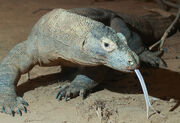
The Komodo dragon (Varanus komodoensis) is probably the world's most infamous lizard. Not only is it the largest and most aggressive living lizard, but it is also one of the most endangered. It belongs to the same family as the monitor lizards, but has evolved seperately for millions of years, becoming incredibly large in the process.
The Komodo dragon is just one of many giant species of animals that have evolved on islands around the world. It is also thought that Komodo dragons originally became so big that they were able to prey on a species of pygmy elephant that inhabited Indonesia thousands of years ago. These pygmy elephants have since become extinct, and the dragons now prey on other mammals, all of which have been introduced into their islands by human populations. The dragons lie hidden for hours upon end, waiting for prey animals to wander past, and then spring from their ambush positions with incredible bursts of speed.
Usually the prey is overpowered within seconds. However, should it escape, the problems for the victim are not yet over. Komodo dragons have a wealth of poisonous bacteria living in their mouths. When they bite prey animals, these bacteria are introduced to the wound, and often cause it to go septic and fester. This results in a slow, painful death.
Female Komodo dragons lay an average of about 20-25 soft, leathery eggs in September. About twice the size of chicken's eggs, they incubate for 8-9 months during the wet season. The young hatch out and immediately start to look for insect prey. However, they have to be careful, because they could well end up on the menus of larger dragons.






